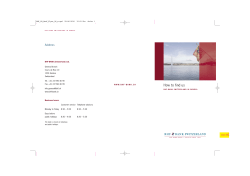
How to automatically test and validate your backup and recovery strategy
How to automatically test
and validate your backup
and recovery strategy
Ruben.Gaspar.Aparicio@cern.ch
November 17th, 2010
CERN IT Department
CH-1211 Geneva 23
Switzerland
www.cern.ch/it
Agenda
• Recovery platform principles
• Use Cases
• Conclusion
CERN IT Department
CH-1211 Geneva 23
Switzerland
www.cern.ch/it
2
Recovery platform principles
•
•
•
•
•
•
•
CERN IT Department
CH-1211 Geneva 23
Switzerland
www.cern.ch/it
•
Validate tape backupsets
Isolation
– no use of catalog: controlfile needs to have all backup
information needed
– capped tnsnames.ora
– no user jobs must run
Automatic cleanup except otherwise configured or an error
arises.
Flexible and easy to customize
Take advantage of a restored database: exports can be
configured -> further validation
Spans several Oracle homes (9i,10g,11g) and OS: solaris &
linux 32 & 64 bits.
Maximize recovery server: several recoveries at the same
time
Easy to deploy: any server can be a recovery server
3
Platform Requirements
• Server with Linux (>RHE4) or Solaris (>8)
• Oracle database server target release(s) for
single instance:
– 9i: 32 & 64 bits
– 10g
– 11gR1 & 11gR2
• Perl (v5.8.5) & bash shell should be
available
• TDP-Oracle libraries (v5.5.3)
• Enough storage to carry intended recoveries on
SAN or NAS.
CERN IT Department
CH-1211 Geneva 23
Switzerland
www.cern.ch/it
4
Component view
• Runs anywhere: ~2600 lines of Perl & Bash
CERN IT Department
CH-1211 Geneva 23
Switzerland
www.cern.ch/it
5
Software layout
/ORA/dbs01/syscontrol/projects/recovery
bin/
etc/
export/
logs/
pfile/
recovery_wrapper.
sh
recoverydef0Definitions
zexp
initTEMPLATE6411201.o
ra
export_wrapper.sh
recoverydef<database>
par files for exp or
expdp
initTEMPLATE6411107.o
ra
recexe.pl
initTEMPLATE6410204.
ora
export.pl
Set of perl
modules
CERN IT Department
CH-1211 Geneva 23
Switzerland
www.cern.ch/it
6
Skeleton of a recovery
Restore &
Recovery
export
CERN IT Department
CH-1211 Geneva 23
Switzerland
www.cern.ch/it
7
Export sequence diagram
Long Time Archive to
Tape
Copy to offsite server
CERN IT Department
CH-1211 Geneva 23
Switzerland
www.cern.ch/it
8
Recovery Server: Installation set up
•
Recoveries are carried out every week, for important db (cron job):
• If recovery_wrapper.sh or similar not available:
9
Traces
• All actions are logged by Logger.pm
• Last successful recovery scripts are kept:
$dirtobackup='/ORA/dbs03/oradata/BACKUP';
• E-mail notifications
10
Important configuration options
ASM configuration
11
Use Case I: user logical error.
Table lost
•
•
Recover a table as it was on 16th Dec 2009 at 05:00am
Do we have an export that could fit?
12
Use Case 1 cont. I
•
Set PITR:
•
Launch it:
•
It will dispatch following scripts in order:
Metalink ID 433335.1
13
Use Case 1 cont. II
job_queue_processes is already 0
14
Use Case 2: using a recovery as
backup to disk
Public interface
Recovery Server
Interconnect interface
RAC
Backup to disk.
SATA disks
01 02
03
04
15
Use Case 2 cont. I
•
Set-up
Just create recovery scripts
•
Run restore/recover:
•
•
Copy archived redo logs from production to recovery server if needed.
Catalog recovered db on production and check it out!
16
Use Case 4: Backup strategy
validation
Public interface
Recovery Server
Interconnect interface
RAC
Backup to disk.
SATA disks
01 02
03
04
05 06 07 08
19
Use case 4 cont. I
• New scripts and templates introduced for VLDB
backup
– backup incremental level 0 … check logical
database skip readonly format…;
– RO tablespaces are backed up every night
• Retention policy changed time window to
redundancy
• Validation possibilities:
– Full restore: time/resource cost
– Partial restore:
20
Use Case 4 cont. II
• Restore/recover the READ WRITE part of the database
• Before open db offline RO tablespace datafiles
• Once db open, restore selected RO tablespaces
21
Use Case 5: schema broken after
application upgrade in a VLDB
• If schema is self-contained
• Kind of tablespace PITR but much simpler
• $tblpitr
• expdp didn’t work in some cases:
22
Use case 5 cont. I
• db_restore.rcv
• db_start.sql
23
Use case 5 cont. II
• Database in size:
– Full: ~420Gb
– Partial (recovering one schema): ~ 71Gb
Full vs Partial recovery
Time in min.
1027
381
Full
Partial
Partial recovery was 63% faster than Full recovery
24
Conclusion
•
•
•
•
•
•
•
More than 3000 recoveries performed so far
Recovery platform shows useful to:
– Can help to estimate real restore/recover time (SLA)
– Validates regularly your tape backups
– Helps to test your backup strategy
– Helps to test your recovery strategy
Helps in a number of use cases
i.e. recover from logical user errors
Maximize your recovery infrastructure -> take consistent exports
Total isolation from production
Easy installation
{http://sourceforge.net/projects/recoveryplat/}
Open source project
– It can be adapted to different tape vendor: netbackup, EMC network
backup
– Add new functionality
25
Thank You !
26
© Copyright 2025





















